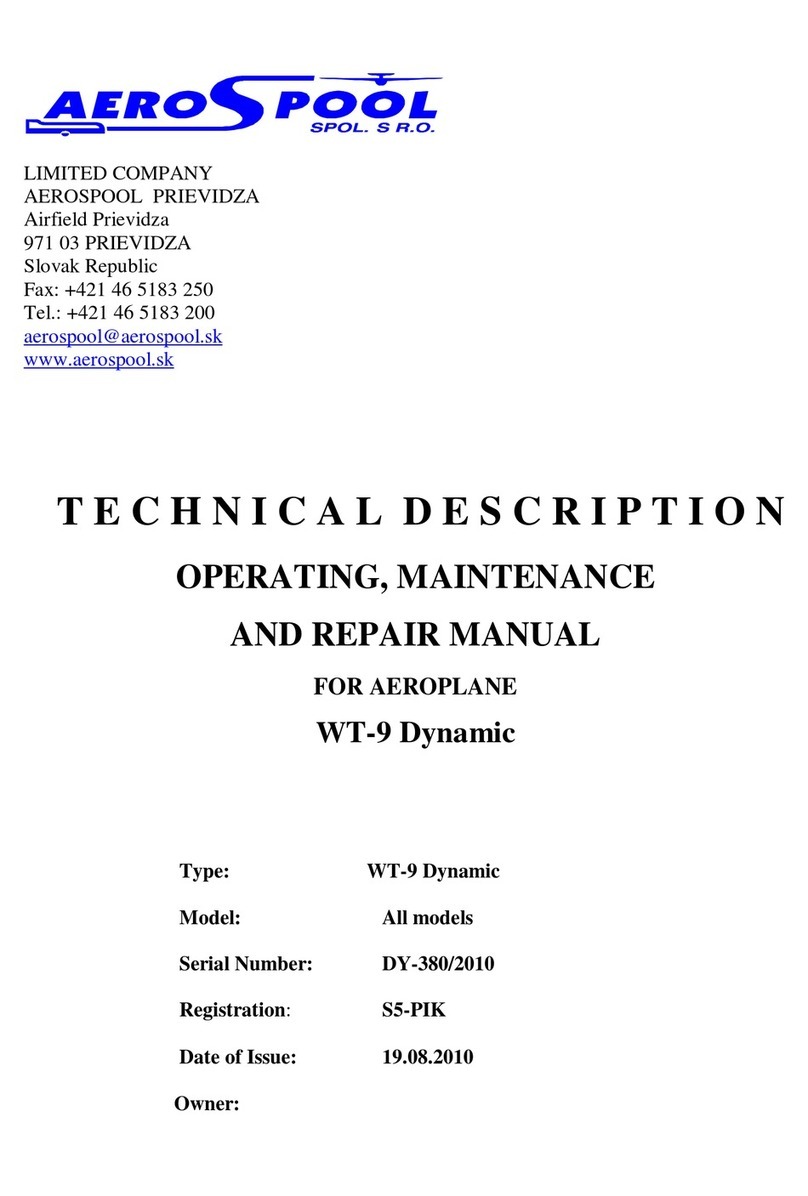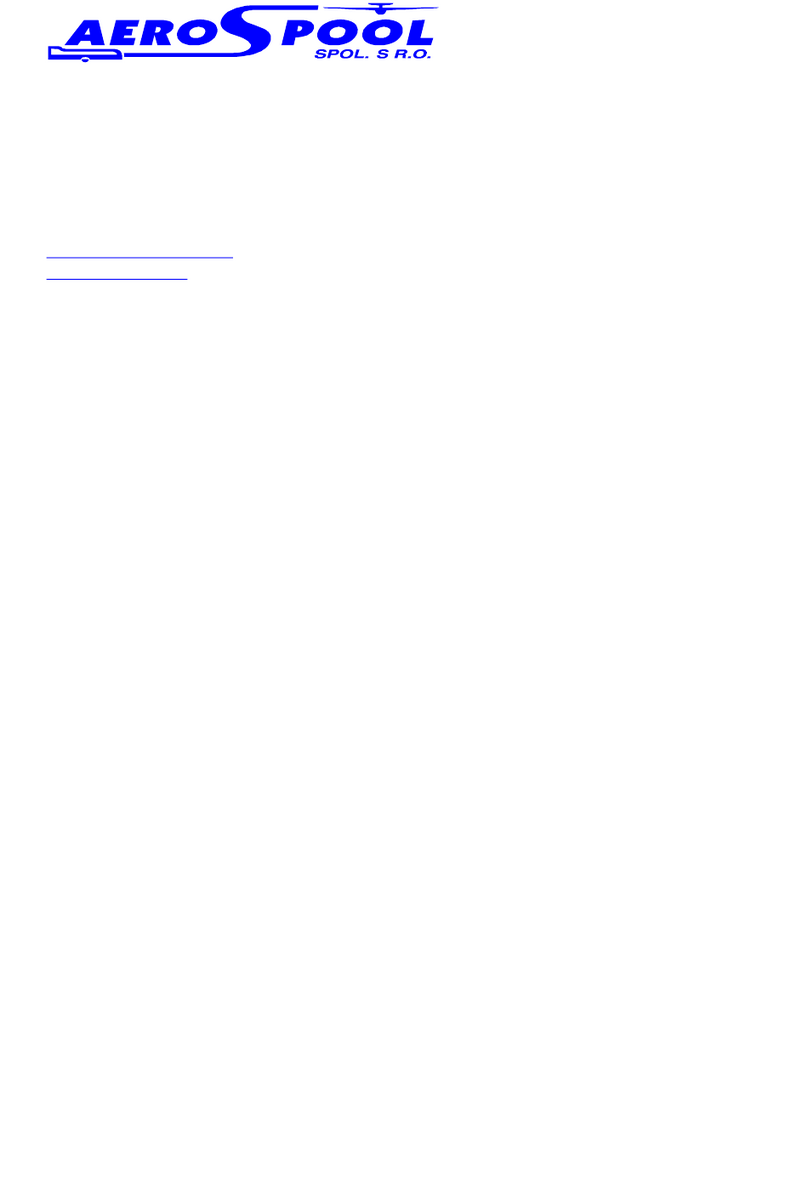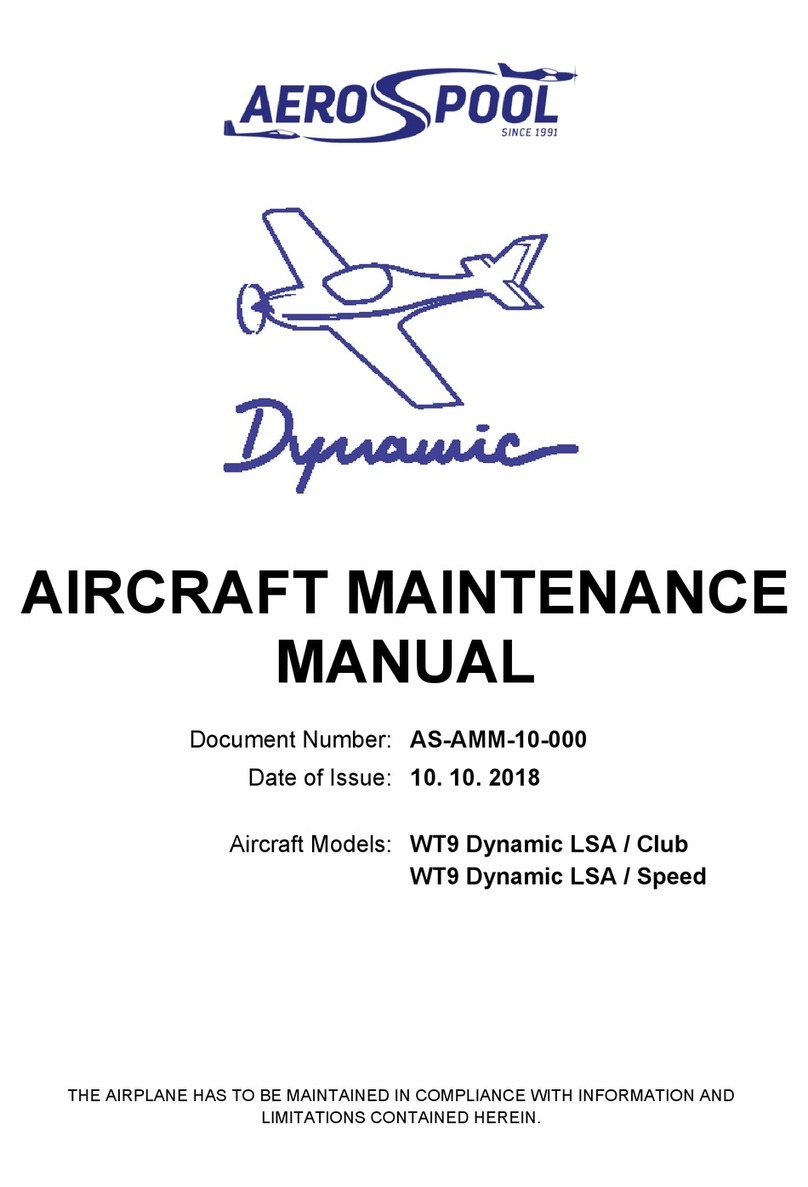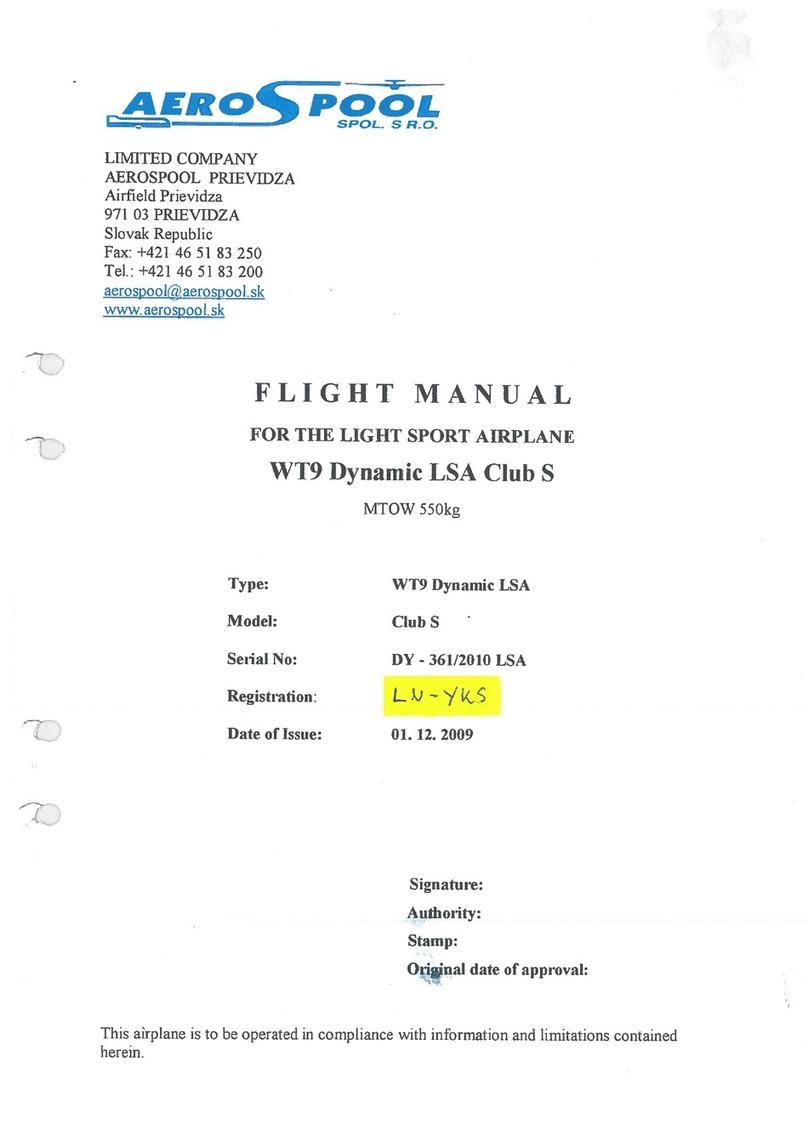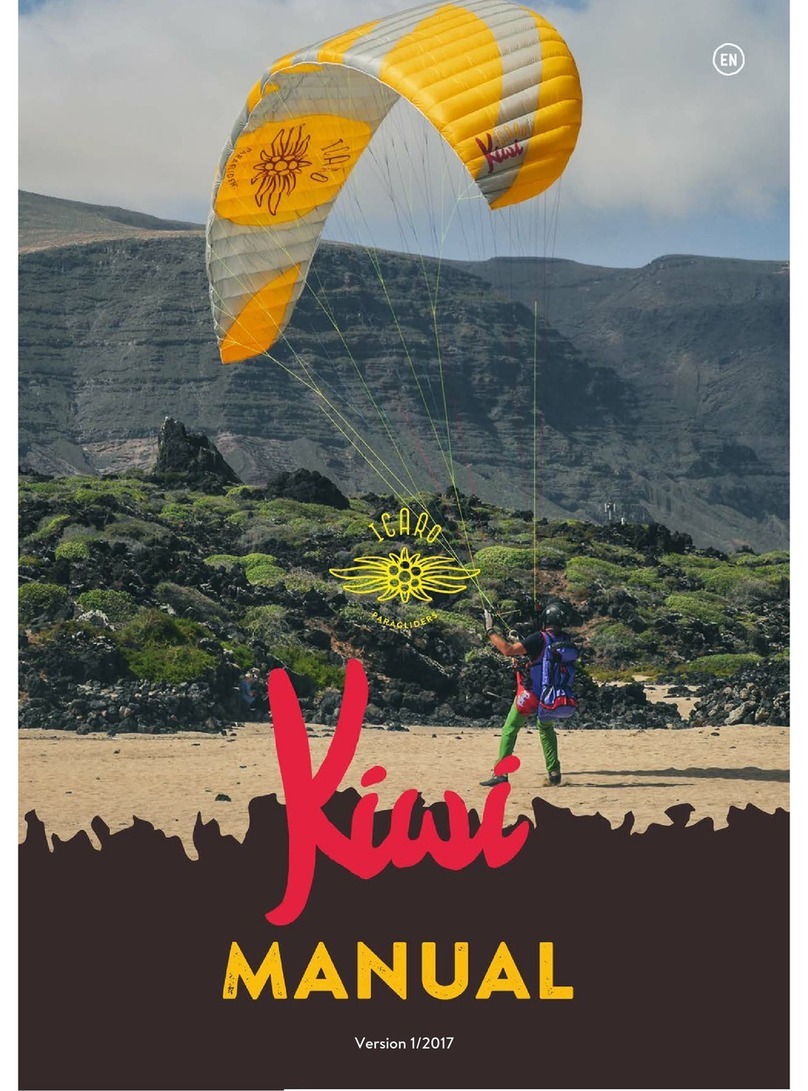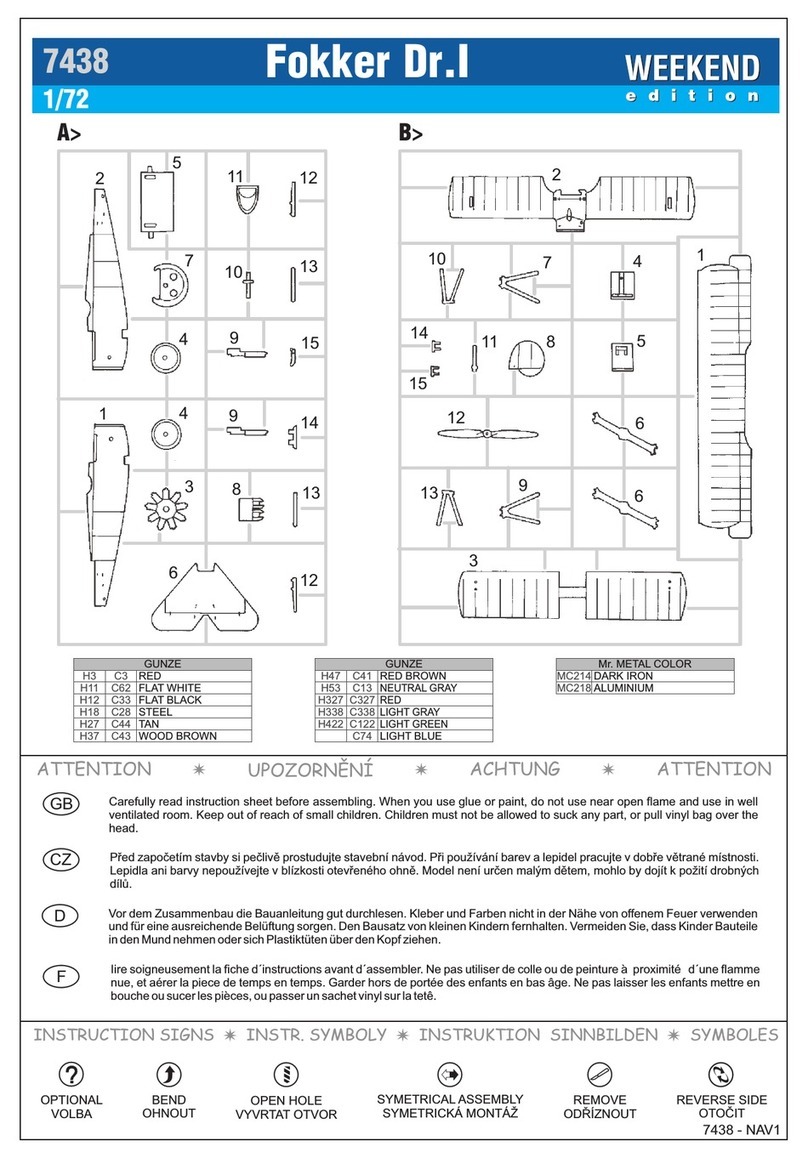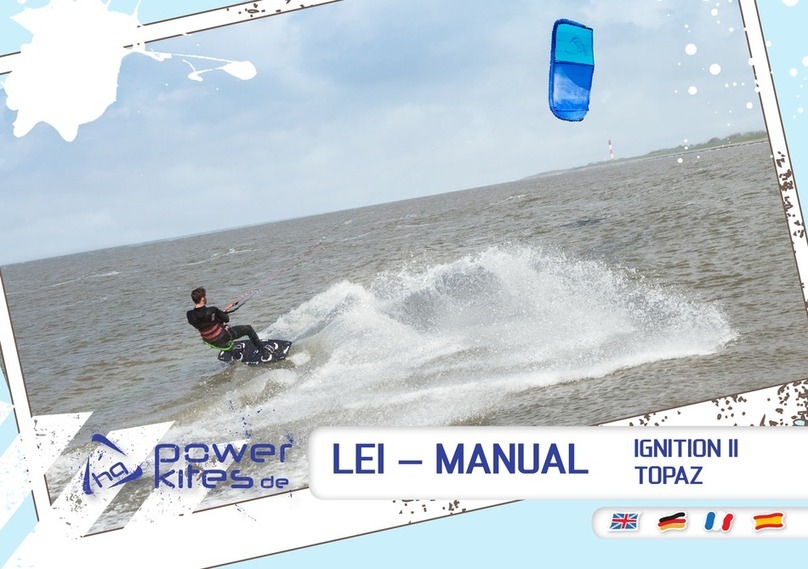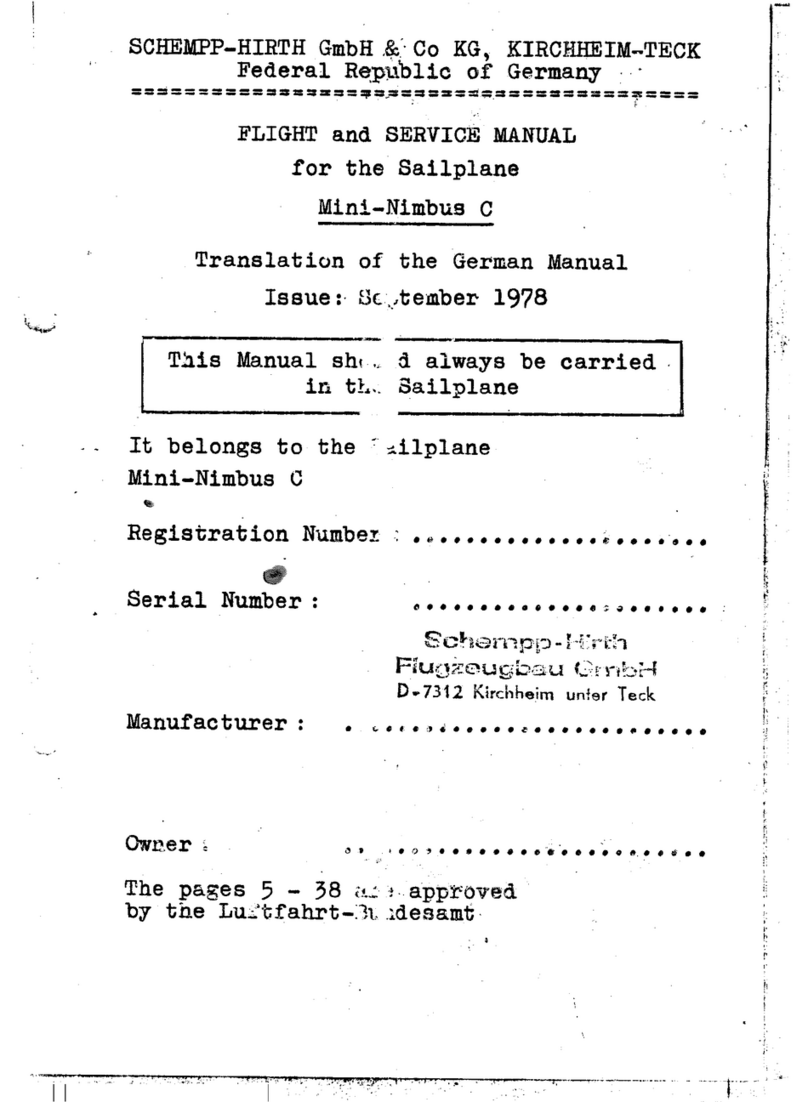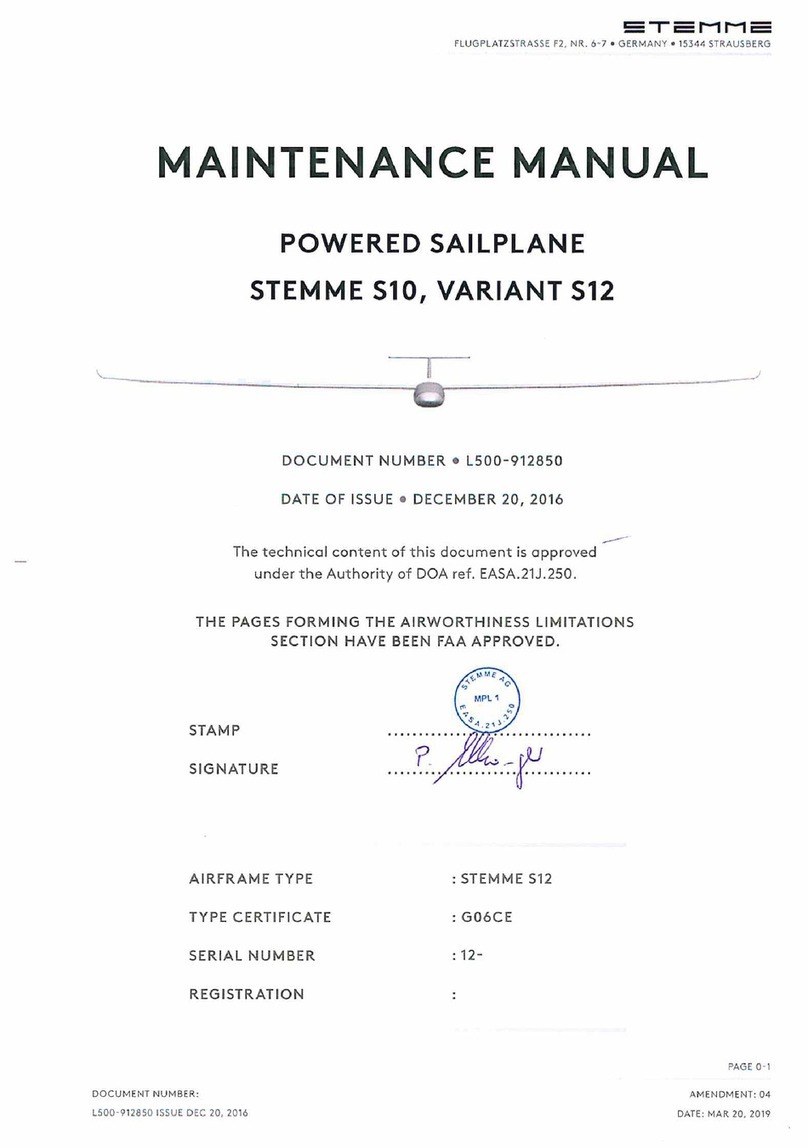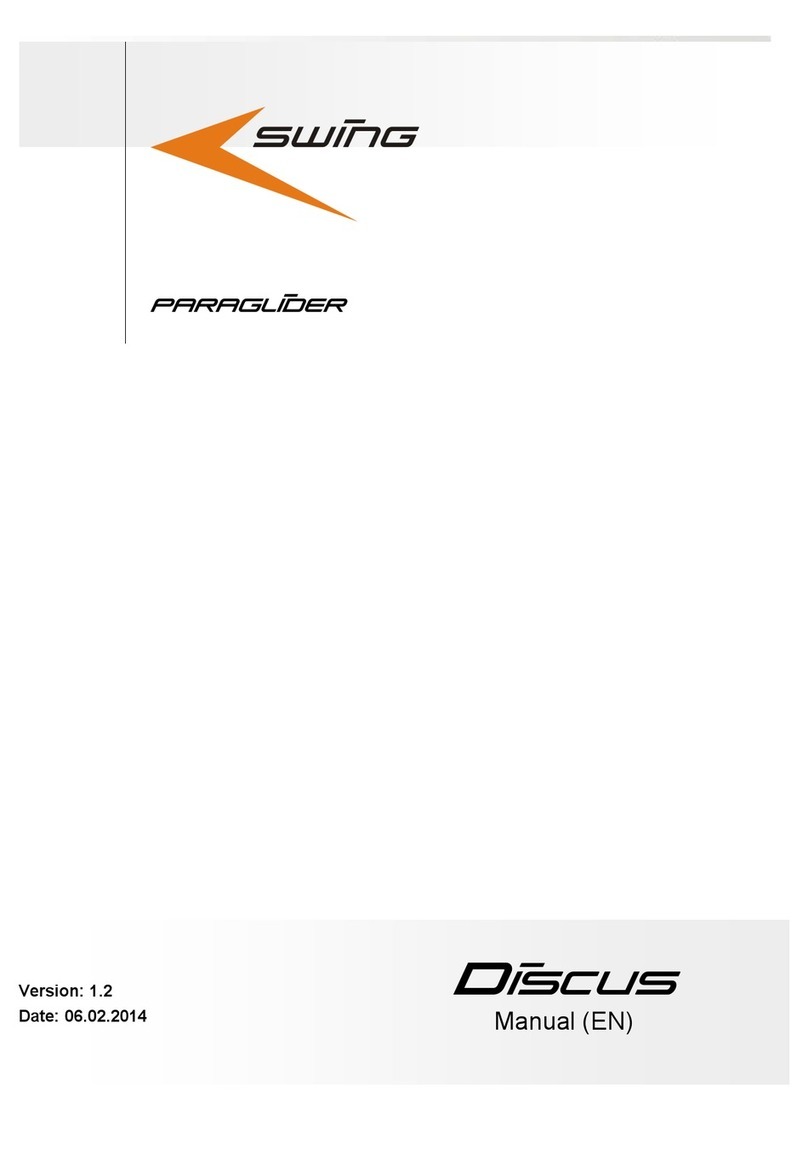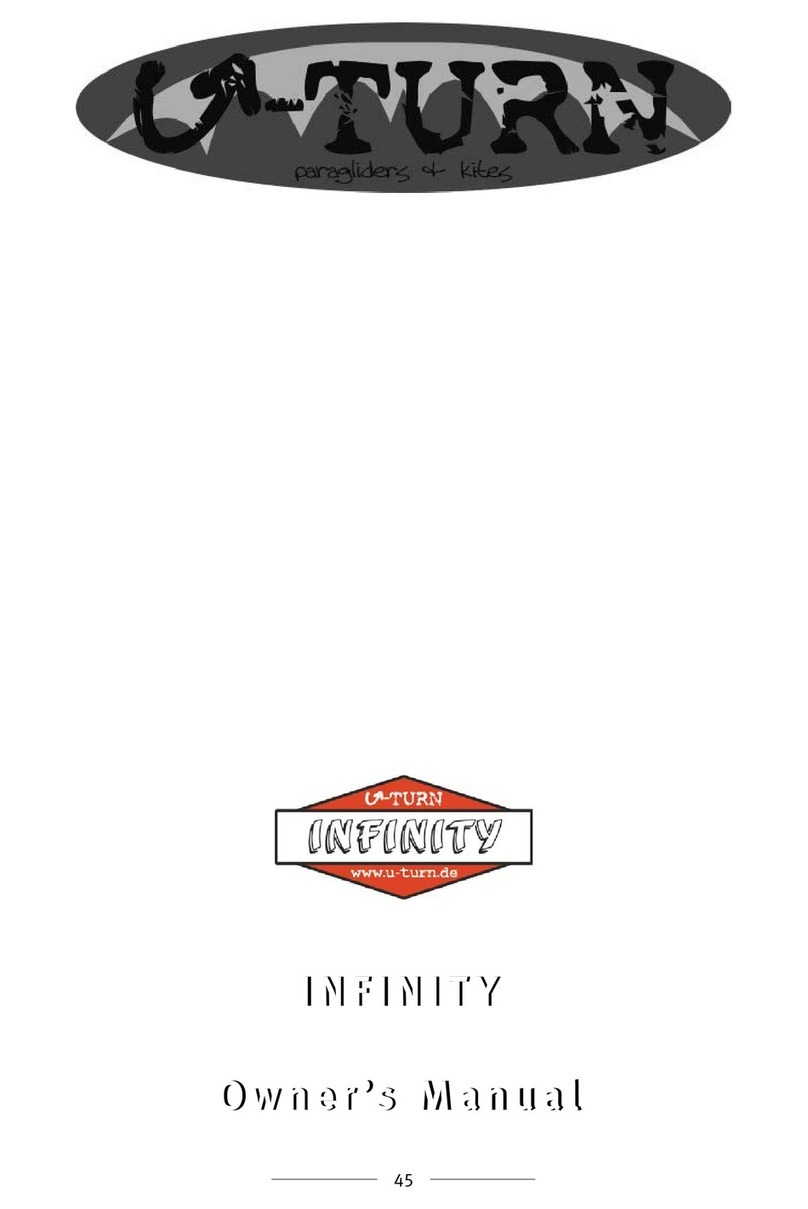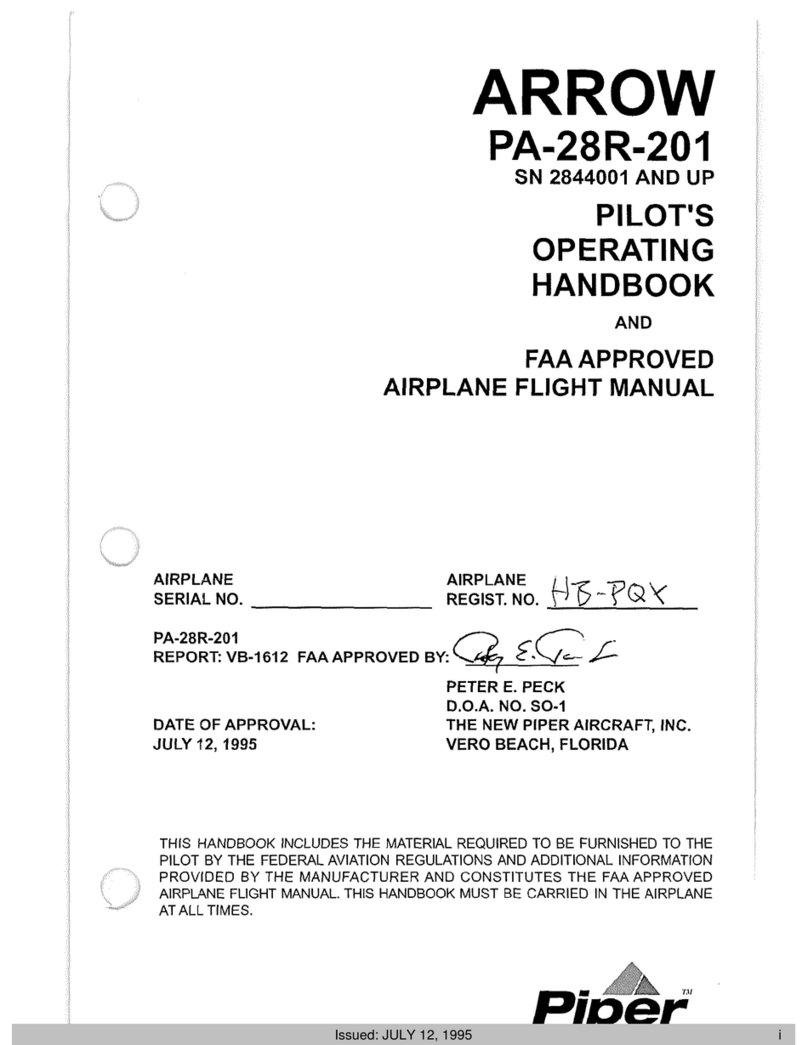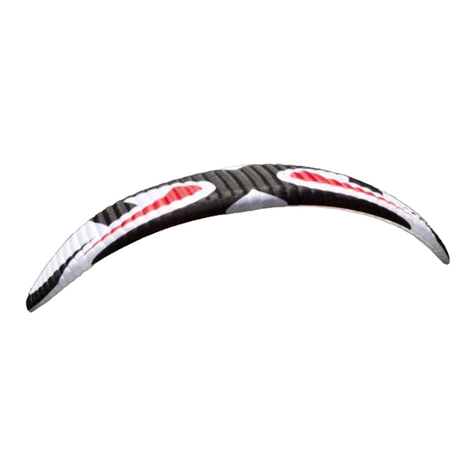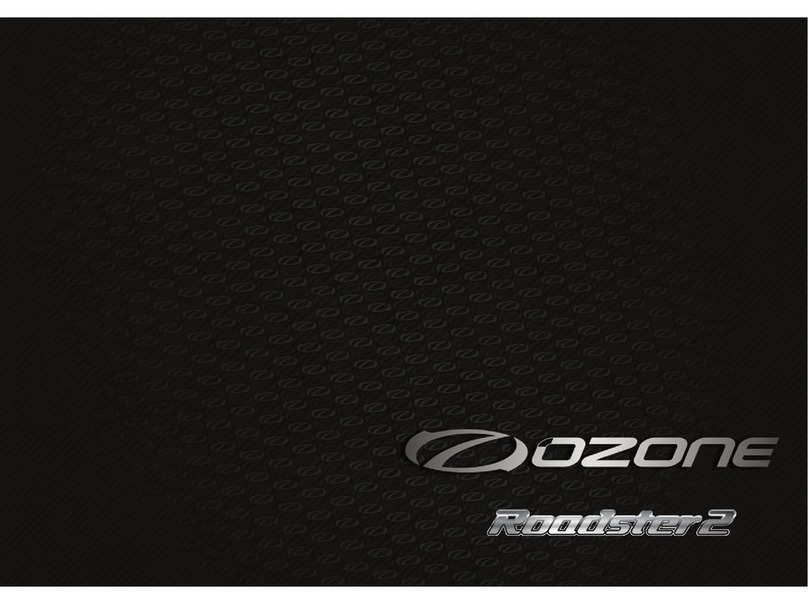Aerospool WT9 Dynamic LSA / Club Owner's manual

PILOT´S OPERATING
HANDBOOK
Document Number:
AS-POH-10-487
Date of Issue:
07. 05. 2019
Aircraft Model:
WT9 Dynamic LSA / Club
Aircraft Serial Number:
DY-487/2013 LSA
Aircraft Registration Number:
F-HVXC
THIS HANDBOOK INCLUDES THE INFORMATION REQUIRED TO BE FURNISHED TO THE PILOT
BY REGULATIONS AND ADDITIONAL INFORMATION PROVIDED BY THE AIRCRAFT
MANUFACTURER –AEROSPOOL, SPOL. S R. O.
PAGES MARKED AS “EASA APPROVED” ARE APPROVED BY EUROPEAN AVIATION SAFETY
AGENCY.
THIS AIRCRAFT MUST BE OPERATED IN COMPLIANCE WITH THE INFORMATION AND
LIMITATIONS STATED IN THIS MANUAL.

This page is left blank intentionally

Initial issue Page A
RECORD OF REVISIONS
Any revision of the present manual, except actual weight data, must be recorded in the following table, and in the
case of approved chapters, endorsed by the responsible airworthiness authority.
The new or amended text in the revised pages will be indicated by a black vertical line in the page margin,
and the revision will be shown on the bottom side of the page.
Revision
Date
Description of Revision
Approved by
Initial issue
07. 05. 2019
New issue.

Page B Initial issue
This page is left blank intentionally

Initial issue Page C
LIST OF EFFECTIVE PAGES
Chapter
Page
Status
Chapter
Page
Status
Title page
Initial issue
3
3-1
Initial issue
Page
Initial issue
EASA Approved
3-2
Initial issue
Page A
Initial issue
EASA Approved
3-3
Initial issue
Page B
Initial issue
EASA Approved
3-4
Initial issue
Page C
Initial issue
EASA Approved
3-5
Initial issue
Page D
Initial issue
EASA Approved
3-6
Initial issue
Page E
Initial issue
EASA Approved
3-7
Initial issue
Page F
Initial issue
EASA Approved
3-8
Initial issue
Page G
Initial issue
EASA Approved
3-9
Initial issue
Page H
Initial issue
EASA Approved
3-10
Initial issue
EASA Approved
3-11
Initial issue
0
0-1
Initial issue
EASA Approved
3-12
Initial issue
0-2
Initial issue
EASA Approved
3-13
Initial issue
0-3
Initial issue
EASA Approved
3-14
Initial issue
0-4
Initial issue
EASA Approved
3-15
Initial issue
0-5
Initial issue
EASA Approved
3-16
Initial issue
0-6
Initial issue
EASA Approved
3-17
Initial issue
EASA Approved
3-18
Initial issue
1
1-1
Initial issue
EASA Approved
3-19
Initial issue
1-2
Initial issue
EASA Approved
3-20
Initial issue
1-3
Initial issue
EASA Approved
3-21
Initial issue
1-4
Initial issue
EASA Approved
3-22
Initial issue
1-5
Initial issue
EASA Approved
3-23
Initial issue
1-6
Initial issue
EASA Approved
3-24
Initial issue
1-7
Initial issue
EASA Approved
3-25
Initial issue
1-8
Initial issue
EASA Approved
3-26
Initial issue
2
2-1
Initial issue
4
4-1
Initial issue
EASA Approved
2-2
Initial issue
4-2
Initial issue
EASA Approved
2-3
Initial issue
4-3
Initial issue
EASA Approved
2-4
Initial issue
4-4
Initial issue
EASA Approved
2-5
Initial issue
4-5
Initial issue
EASA Approved
2-6
Initial issue
4-6
Initial issue
EASA Approved
2-7
Initial issue
4-7
Initial issue
EASA Approved
2-8
Initial issue
4-8
Initial issue
EASA Approved
2-9
Initial issue
4-9
Initial issue
EASA Approved
2-10
Initial issue
4-10
Initial issue
EASA Approved
2-11
Initial issue
4-11
Initial issue
EASA Approved
2-12
Initial issue
4-12
Initial issue
EASA Approved
2-13
Initial issue
4-13
Initial issue
EASA Approved
2-14
Initial issue
4-14
Initial issue
EASA Approved
2-15
Initial issue
4-15
Initial issue
EASA Approved
2-16
Initial issue
4-16
Initial issue
4-17
Initial issue

Page D Initial issue
Chapter
Page
Status
Chapter
Page
Status
4
4-18
Initial issue
EASA Approved
6-17
Initial issue
4-19
Initial issue
EASA Approved
6-18
Initial issue
4-20
Initial issue
EASA Approved
6-19
Initial issue
4-21
Initial issue
EASA Approved
6-20
Initial issue
4-22
Initial issue
EASA Approved
6-21
Initial issue
4-23
Initial issue
EASA Approved
6-22
Initial issue
4-24
Initial issue
EASA Approved
6-23
Initial issue
4-25
Initial issue
EASA Approved
6-24
Initial issue
4-26
Initial issue
4-27
Initial issue
7
7-1
Initial issue
4-28
Initial issue
7-2
Initial issue
7-3
Initial issue
5
5-1
Initial issue
7-4
Initial issue
EASA Approved
5-5
Initial issue
7-5
Initial issue
EASA Approved
5-3
Initial issue
7-6
Initial issue
EASA Approved
5-4
Initial issue
7-7
Initial issue
EASA Approved
5-5
Initial issue
7-8
Initial issue
EASA Approved
5-6
Initial issue
7-9
Initial issue
EASA Approved
5-7
Initial issue
7-10
Initial issue
EASA Approved
5-8
Initial issue
7-11
Initial issue
EASA Approved
5-9
Initial issue
7-12
Initial issue
EASA Approved
5-10
Initial issue
7-13
Initial issue
EASA Approved
5-11
Initial issue
7-14
Initial issue
EASA Approved
5-12
Initial issue
7-15
Initial issue
EASA Approved
5-13
Initial issue
7-16
Initial issue
EASA Approved
5-14
Initial issue
7-17
Initial issue
EASA Approved
5-15
Initial issue
7-18
Initial issue
EASA Approved
5-16
Initial issue
7-19
Initial issue
7-20
Initial issue
6
6-1
Initial issue
7-21
Initial issue
EASA Approved
6-2
Initial issue
7-22
Initial issue
EASA Approved
6-3
Initial issue
7-23
Initial issue
EASA Approved
6-4
Initial issue
7-24
Initial issue
EASA Approved
6-5
Initial issue
7-25
Initial issue
EASA Approved
6-6
Initial issue
7-26
Initial issue
EASA Approved
6-7
Initial issue
7-27
Initial issue
EASA Approved
6-8
Initial issue
7-28
Initial issue
EASA Approved
6-9
Initial issue
7-29
Initial issue
EASA Approved
6-10
Initial issue
7-30
Initial issue
EASA Approved
6-11
Initial issue
7-31
Initial issue
EASA Approved
6-12
Initial issue
7-32
Initial issue
EASA Approved
6-13
Initial issue
7-33
Initial issue
EASA Approved
6-14
Initial issue
7-34
Initial issue
EASA Approved
6-15
Initial issue
7-35
Initial issue
EASA Approved
6-16
Initial issue
7-36
Initial issue

Initial issue Page E
Chapter
Page
Status
Chapter
Page
Status
7
7-37
Initial issue
7-38
Initial issue
7-39
Initial issue
7-40
Initial issue
7-41
Initial issue
7-42
Initial issue
7-43
Initial issue
7-44
Initial issue
8
8-1
Initial issue
8-2
Initial issue
8-3
Initial issue
8-4
Initial issue
8-5
Initial issue
8-6
Initial issue
8-7
Initial issue
8-8
Initial issue
8-9
Initial issue
8-10
Initial issue
8-11
Initial issue
8-12
Initial issue
8-13
Initial issue
8-14
Initial issue
8-15
Initial issue
8-16
Initial issue
8-17
Initial issue
8-18
Initial issue
8-19
Initial issue
8-20
Initial issue
9
9-1
Initial issue
9-2
Initial issue
9-3
Initial issue
9-4
Initial issue
9-5
Initial issue
9-6
Initial issue

Page F Initial issue
Chapter
Page
Date
Chapter
Page
Date

Initial issue Page G
TABLE OF CONTENTS
Chapter Chapter Name
0...................................................................................................................INTRODUCTION
1.............................................................................................GENERAL INFORMATION
2.........................................................................................................................LIMITATIONS
3........................................................................................ EMERGENCY PROCEDURES
4.................................................................................................NORMAL PROCEDURES
5................................................................................................................... PERFORMANCE
6.........................................WEIGHT AND BALANCE, AND EQUIPMENT LIST
7....................................................DESCRIPTION OF AIRCRAFT AND SYSTEMS
8.......................................................................................HANDLING AND SERVICING
9..................................................................................................................... SUPPLEMENTS

Page H Initial issue
This page is left blank intentionally

Initial issue Page 0-1
0INTRODUCTION
TABLE OF CONTENTS
0.1 GENERAL ...............................................................................................................0-2
0.2 LIST OF STANDARDS...............................................................................................0-2
0.3 CONTINUED AIRWORTHINESS................................................................................0-2
0.4 AIRCRAFT MANUFACTURER CONTACT INFORMATION............................................0-2
0.5 DATA LOCATION AND CONTACT INFORMATION FOR RECOVERY OF APPROVAL
DOCUMENTATION.................................................................................................0-2
0.6 SYMBOLS, ABBREVIATIONS AND TERMINOLOGY....................................................0-3
Speed..............................................................................................................................0-3
Meteorological Terms....................................................................................................0-3
Power Plant....................................................................................................................0-4
Flight Performance and Flight Planning.........................................................................0-4
Weight and Balance .......................................................................................................0-4
Equipment......................................................................................................................0-5
Miscellaneous.................................................................................................................0-5
0.7 CONVERSION FACTORS..........................................................................................0-6
Length or Altitude ..........................................................................................................0-6
Speed..............................................................................................................................0-6
Pressure..........................................................................................................................0-6
Weight............................................................................................................................0-6
Volume ...........................................................................................................................0-6
Area ................................................................................................................................0-6

Page 0-2 Initial issue
0.1 General
This Pilot´s Operating Handbook (POH) has been prepared to provide pilots and instructors with all information
needed for the safe and efficient operation of this aircraft. This manual contains supplementary data supplied by the
manufacturer.
Before using the aircraft, read this handbook carefully: an in depth knowledge of aircraft features and limitations will
allow you to operate the aircraft safely.
0.2 List of Standards
EASA Approval Basis was Standard Specification for Design and Performance of a Light Sport Airplane ASTM F2245-
10c. This aircraft is not type certified and is accepted for EASA Permit to Fly. See the related EASA Flight Conditions for
the operational limitations and airworthiness conditions.
The noise requirements are shown according to Certification Specifications and Acceptable Means of Compliance
for Aircraft Noise CS-36, Amendment 3 dated 20th January 2013.
0.3 Continued Airworthiness
Technical publications for continued airworthiness are released on the Aerospool website www.aerospool.sk and they
may be downloaded free of charge.
Rotax Aircraft Engines releases technical publications on their website www.flyrotax.com from which they may be
downloaded free of charge.
Documentation updates for the propeller may be downloaded on www.helices-evra.com.
Documentation updates for avionics may be downloaded on the avionics manufacturer’s website.
It is the responsibility of the owner/operator of the aircraft to keep the aircraft and its documentation up to date and
to comply with all technical publications. The owner/operator is responsible for keeping a current POH onboard every
flight.
0.4 Aircraft Manufacturer Contact Information
Aerospool spol. s r. o.
Letisková 10
971 03 Prievidza
Slovak republic
Web: www.aerospool.sk
E-mail: dynamic@aerospool.sk
0.5 Data Location and Contact Information for Recovery of Approval
Documentation
European Aviation Safety Agency (EASA)
Postfach 10 12 53
50452 Koeln
Germany
Web: www.easa.europa.eu
E-mail: [email protected].eu

Initial issue Page 0-3
0.6 Symbols, Abbreviations and Terminology
Speed
CAS Calibrated airspeed; Indicated speed in kilometers per hour corrected for installation and instrument
errors. CAS is equal to TAS in standard atmospheric conditions at MSL.
KCAS CAS indicated in knots.
IAS Indicated airspeed in kilometers per hour as shown on the airspeed indicator.
KIAS IAS indicated in knots.
GS Ground Speed. Speed of the aircraft relative to the ground.
TAS True airspeed. Speed of the aircraft relative to the air. TAS is CAS corrected for altitude and
temperature errors.
vAManeuvering airspeed. Maximum speed at which the aircraft is not overstressed at full deflection
of control surfaces.
vFE Maximum airspeed with flaps extended.
vLOF Airspeed at liftoff.
vNE Airspeed which must never be exceeded in any operation.
vNO Normal operating airspeed (cruise speed).
vRA Maximum rough airspeed.
vSThe power-off stall airspeed with the aircraft in its standard configuration.
vSO The power-off stall airspeed with the aircraft in landing configuration.
vXBest angle-of-climb airspeed.
vYBest rate-of-climb airspeed.
v50 Airspeed at height 15m (50 ft).
Meteorological Terms
AGL Above Ground Level
MSL Above Mean Sea Level
ISA International Standard Atmosphere at which air is identified as a dry gas. The temperature
at mean sea level is 15° Celsius (59° F), the air pressure at sea level is 1013.25 mbar (29.92 inHg),
the temperature gradient up to the altitude at which the temperature reaches -56.5 °C
(-67.9 °F) is -0.0065 °C/m (-0.0036 °F/ft) and 0 °C/m (0 °F/ft) above.
OAT Outside air temperature.
Indicated Pressure Altitude
Altitude reading with altimeter set to 1013.25 mbar (29.92 inHg) air pressure.
Pressure Altitude
Altitude measured at standard pressure at MSL (1013.25 mbar / 29.92 inHg) using
a barometric altimeter. Pressure altitude is the indicated altitude corrected for installation
and instrument errors. Within this manual the instrument errors are assumed to be zero.
Aerodrome/Airport Pressure
Actual atmospheric pressure at the aerodrome/airport altitude.
Wind The wind speeds used in the diagrams in this manual should be referred to as headwind
or tailwind components of the measured wind.

Page 0-4 Initial issue
Power Plant
hp Horsepower
kW Kilowatt
Takeoff Power
Maximum engine power for takeoff.
Maximum Continuous Power
Maximum permissible continuous engine output power during flight.
Flight Performance and Flight Planning
Demonstrated Crosswind Component
The maximum speed of the crosswind component at which the maneuverability of the aircraft
during takeoff and landing has been demonstrated during type certification test flights.
Service Ceiling
The altitude at which the maximum rate of climb is 100 fpm / 0.5 m/s.
Weight and Balance
Reference Datum (RD)
An imaginary vertical plane from which all horizontal distances for the center of gravity calculations are
measured. The Reference Datum is located 1.975 m / 77.76 in forward direction from inner surface
of the firewall, perpendicular to the longitudinal axis of the aircraft.
Station A defined point along the longitudinal axis which is generally presented as a specific distance
from the reference datum.
Lever Arm The horizontal distance from the reference datum to the center of gravity (of a component).
Moment The weight of a component multiplied by its lever arm.
Center of Gravity (CG)
Point of equilibrium for the aircraft weight.
CG position
Distance from the reference datum to the CG. It is determined by dividing the total moment
(sum of the individual moments) by the total weight.
Center of Gravity Limits
The CG range which an aircraft with a given weight must be operated within.
MAC Mean Aerodynamic Chord
Usable Fuel
The amount of fuel available for the flight plan calculation.
Unusable Fuel
The amount of fuel remaining in the tank, which cannot be safely used in flight.
Empty Weight
Weight of the aircraft including all operating fluids and maximum oil amount without unusable fuel.
Basic Empty Weight
Weight of the aircraft including all operating fluids and maximum oil amount with unusable fuel.
Useful Load
The difference between takeoff weight and empty weight.
Maximum Takeoff Weight
Maximum weight permissible for takeoff.

Initial issue Page 0-5
Equipment
ALT Altitude or Altimeter
ASI Airspeed Indicator
CDI Course Deviation Indicator
COMM Communication Transceiver
CRS Course
EFIS Electronic Flight Information System
ELT Emergency Locator Transmitter
EMS Engine Monitoring System
EPS Emergency Parachute System
GPS Global Positioning System
HDG Heading
MFD Multi-function Display
OEM Original Equipment Manufacturer, company that controls the engineering and design rights for the LSA
or an assembly, subassembly, accessory, or part installed in the aircraft, the consumable material, tools,
fixtures, and test equipment used to service or maintain the aircraft.
VSI Vertical Speed Indicator
Miscellaneous
ATC Air Traffic Control
CS-LSA Certification Specification for Light Sport Aeroplanes
EASA European Aviation Safety Agency
IFR Instrument Flight Rules
PIC Pilot in Command
POH Pilot’s Operating Handbook
VFR Visual Flight Rules
RWY Runway

Page 0-6 Initial issue
0.7 Conversion Factors
Length or Altitude
1 [m] = 3.281 [ft]
1 [ft] = 0.305 [m]
1 [m] = 39.37 [in]
1 [in] = 0.0254 [m]
1 [km] = 0.5399 [nm]
1 [nm] = 1.852 [km]
Speed
1 [km/h] = 0.54 [knots]
1 [knots] = 1.852 [km/h]
1 [m/s] = 1.9425 [knots]
1 [knots] = 0.5148 [m/s]
1 [m/s] = 196.86 [fpm]
1 [fpm] = 0.00508 [m/s]
Pressure
1 [atm] = 1013.25 [mbar] = 101325 [Pa] = 29.92 [inHg]
1 [inHg] = 0.03342 [atm] = 33.865 [mbar] = 3386.5 [Pa]
Weight
1 [kg] = 2.205 [lb]
1 [lb] = 0.454 [kg]
Volume
1 [liter] = 0.2642 [U. S. gallon]
1 [U. S. gallon] = 3.785 [liter]
Area
1 [m2] = 10.76 [ft2]
1 [ft2] = 0.0929 [m2]

Initial issue Page 1-1
1GENERAL INFORMATION
TABLE OF CONTENTS
1.1 GENERAL ...............................................................................................................1-2
1.2 INTRODUCTION TO THE POH..................................................................................1-2
Warnings, Cautions and Notes.......................................................................................1-2
Procedures .....................................................................................................................1-2
1.3 INTRODUCTION TO THE AIRCRAFT .........................................................................1-3
Dimensions.....................................................................................................................1-3
Engine.............................................................................................................................1-3
Propeller.........................................................................................................................1-3
Three View Drawing.......................................................................................................1-4
Ground Turning Clearance .............................................................................................1-5
1.4 SUMMARY OF PERFORMANCE...............................................................................1-6
Weights ..........................................................................................................................1-6
Top and Cruise Speeds...................................................................................................1-6
1.4.2.1 Top Speeds at Sea Level.................................................................................................1-6
1.4.2.2 Cruise Speeds at Altitudes and Power Setting...............................................................1-6
Fuel Operating Ranges ...................................................................................................1-7
Rate of Climb..................................................................................................................1-7
Stall Speeds ....................................................................................................................1-7
Approved Fuel Types and Fuel Capacity ........................................................................1-8
Maximum Engine Power Output....................................................................................1-8
Specific Loadings ............................................................................................................1-8

Page 1-2 Initial issue
1.1 General
This chapter contains information of general interest to pilots and owners. You will find useful information to
familiarize yourself with the aircraft, such as dimensions, ground turning clearance, loading, fuelling and summary of
performance.
1.2 Introduction to the POH
Warnings, Cautions and Notes
The following highlighting styles are used in this handbook to focus attention on particular information that is
important.
WARNING
Warnings are used to call attention to operating procedures that if
not strictly observed, may result in personal injury or loss of life!
CAUTION
Cautions are used to call attention to operating procedures that if
not strictly observed, may result in damage of equipment!
NOTE
Notes are used to call attention to any special item, not directly
related to safety, but which is important or unusual.
Procedures
The procedures, listed in this POH are formed into tables with three columns as shown in the example below:
Column A
Column B
Column C
a.
Item 1
OFF
b.
ITEM 2
As required
c.
ITEM 3 handle
OPEN, carefully
Column A contains letters in the alphabetical order, defining the order of the actions in the procedure.
Plain text in Column B defines the item, which is not marked by a placard in the cabin, but is generally identifiable; or
supplements the other text.
Bold capital text in column B defines the item, which is marked by a placard with the identical expression in the cabin.
Plain text in Column C defines the setting or action which is generally understandable; or supplements the other text.
Capital text in Column C defines the setting or action, which usually changes the state of the item from one setting to
another; and/or emphasizes the importance of the setting or action.
Bold capital text in Column C defines the setting or action, which is marked by a placard with the identical expression
in the cabin.

Initial issue Page 1-3
1.3 Introduction to the Aircraft
Dimensions
Wing area
10.500 m2
112.98 ft2
Wing span
8.926 m
29.28 ft
Overall length
6.460 m
21.19 ft
Maximum height
1.850 m
6.07 ft
Wheel base
1.400 m
4.59 ft
Main landing gear track
2.240 m
7.35 ft
Maximum propeller diameter
1.750 m
68.90 in
Mean aerodynamic chord (MAC)
1.172 m
3.84 ft
Engine
Number of engines
1
Number of cylinders
4
Engine manufacturer
BRP-Rotax GmbH & Co KG
Engine model number
Rotax 912 ULS2
Engine type
Horizontally opposed, geared, normally
aspirated, spark ignition
Cooling
Combined liquid and air
Maximum takeoff power at 5800 rpm (max. 5 min.)
73.5 kW / 100 hp
Maximum continuous power at 5500 rpm
69.0 kW / 92.5 hp
Propeller
Number of propellers
1
Propeller manufacturer
PRODUCTION EVRA, Creil, France
Propeller model number
EVRA PerformanceLine 175/xxx/805.5
Number of blades
3
Propeller diameter
1.750 m (68.90 in)
Propeller type
Fixed pitch, ground adjustable
Pitch setting (measured 200 mm from blade tip)
23°

Page 1-4 Initial issue
Three View Drawing
Fig. 1-1 Three view drawing
Other manuals for WT9 Dynamic LSA / Club
1
Table of contents
Other Aerospool Aircraft manuals
